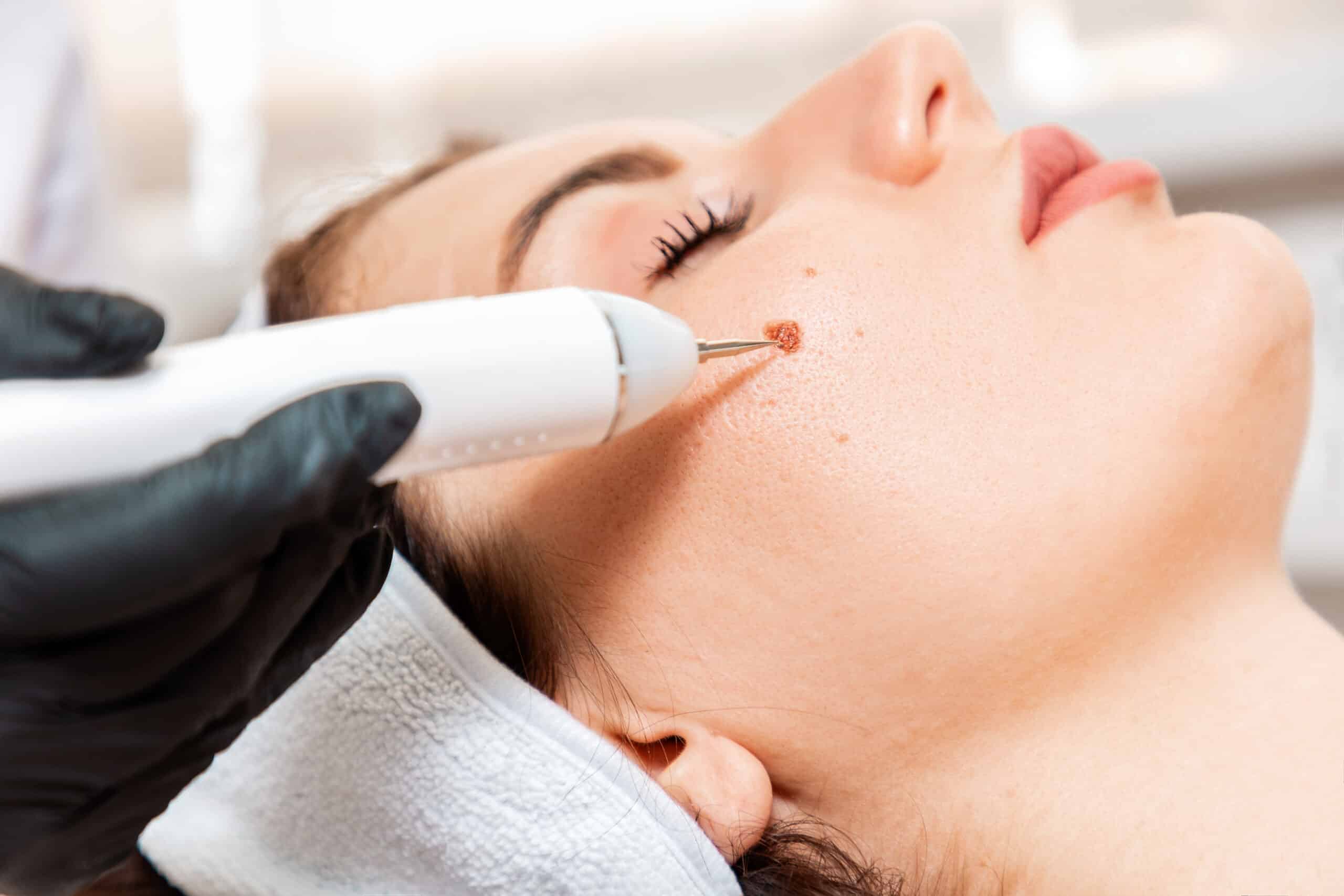Radiance Restored
Mole Removal Treatment
Advanced Mole Removal Treatment Treatment in Kharagpur
Overview
Mole Removal Treatment in Kharagpur
At Zenith Aesthetics, Kharagpur, we offer safe, advanced, and scar-minimizing mole removal treatments tailored to your skin type and cosmetic goals. Moles—whether raised, flat, or pigmented—are common skin growths caused by clusters of pigmented cells. While most are harmless, many individuals choose to remove them for cosmetic reasons or due to irritation caused by shaving or clothing friction.
Our clinic uses cutting-edge, USFDA-approved methods like Radiofrequency (RF) ablation, Laser Mole Removal, and Surgical Excision. These techniques ensure precise removal with minimal scarring and quick recovery. Each treatment begins with a detailed dermatological assessment to determine the nature of the mole—benign, pre-cancerous, or suspicious—before selecting the safest method for removal.
With minimal downtime, most patients return to their routine on the same or next day. Healing typically occurs within 7–10 days, with post-treatment care provided to support scar-free skin regeneration.
Book a personalized consultation today to discover how we can help you achieve radiant, flawless skin.

Talk to Our Experts
Mole Removal Treatment in Kharagpur
At Zenith Aesthetics, Kharagpur, we offer safe, advanced, and scar-minimizing mole removal treatments tailored to your skin type and cosmetic goals. Moles—whether raised, flat, or pigmented—are common skin growths caused by clusters of pigmented cells. While most are harmless, many individuals choose to remove them for cosmetic reasons or due to irritation caused by shaving or clothing friction.
Our clinic uses cutting-edge, USFDA-approved methods like Radiofrequency (RF) ablation, Laser Mole Removal, and Surgical Excision. These techniques ensure precise removal with minimal scarring and quick recovery. Each treatment begins with a detailed dermatological assessment to determine the nature of the mole—benign, pre-cancerous, or suspicious—before selecting the safest method for removal.
With minimal downtime, most patients return to their routine on the same or next day. Healing typically occurs within 7–10 days, with post-treatment care provided to support scar-free skin regeneration.
What are Moles / Warts / Skin Tag / Freckles / CORN and Callus?
These are common skin growths or conditions that vary in appearance and cause. Moles are pigmented spots caused by clustered skin cells. Warts are rough, raised growths caused by the HPV virus. Skin tags are soft, flesh-colored outgrowths often found in skin folds. Freckles are small brown spots triggered by sun exposure. Corns are thick, hardened layers of skin caused by repeated pressure or friction, usually on feet. Calluses are similar but larger and flatter. While mostly harmless, they can be removed for cosmetic or comfort reasons at clinics like Zenith Aesthetics, Kharagpur.
What Causes a Mole?
Moles, or melanocytic nevi, are caused by clusters of melanocytes—the skin cells responsible for producing melanin (the pigment that gives your skin its color). Instead of spreading evenly across the skin, these cells grow in concentrated spots, forming a mole.
Common Causes of Moles:
- Genetics
– Moles often run in families. If your parents have many moles, you’re more likely to develop them too. - Sun Exposure
– Ultraviolet (UV) rays from the sun can stimulate melanocyte activity, leading to new moles or darkening of existing ones. - Hormonal Changes
– Puberty, pregnancy, or hormonal therapy may trigger new mole formation or changes in existing moles. - Age
– Most moles appear in childhood and adolescence, but new ones can appear into your 30s or 40s.
Types of Moles
Moles, medically known as nevi, can vary in color, size, and location. Understanding their types helps determine whether they are harmless or may need medical attention. Here are the most common types:
1. Congenital Moles
- Present at birth
- Can vary in size from small to large
- Larger ones may have a slightly increased risk of becoming cancerous
2. Acquired Moles
- Develop after birth, usually during childhood or early adulthood
- Most common type
- Usually round, brown, and uniform in color
3. Junctional Moles
- Flat, round, and dark brown or black
- Form at the junction of the top and middle layers of skin
- Typically benign but should be monitored for changes
4. Compound Moles
- Raised and may be light brown to flesh-colored
- Cells are found in both the surface and deeper skin layers
- Often hair-bearing and dome-shaped
5. Dermal (Intradermal) Moles
- Usually skin-colored or light brown
- Raised and soft to touch
- Common in adults and usually harmless
6. Atypical (Dysplastic) Moles
- Irregular shape, uneven color, and larger than normal
- May have a higher risk of developing into melanoma
- Should be regularly checked by a dermatologist
How Do I Know if a Mole Is Cancer?
Most moles are harmless, but some may develop into melanoma, a serious form of skin cancer. To identify suspicious or cancerous moles, dermatologists recommend using the ABCDE rule, which helps spot warning signs early.
A – Asymmetry
One half of the mole doesn’t match the other in shape or size.
B – Border
Edges are irregular, ragged, notched, or blurred.
C – Color
Uneven shades of brown, black, tan, red, white, or blue.
D – Diameter
Larger than 6 mm (about the size of a pencil eraser), though cancer can be smaller too.
E – Evolving
The mole changes in size, shape, color, or texture—or starts itching, bleeding, or crusting.
Skin Tags
Skin tags (medically known as acrochordons) are small, soft, benign skin growths that often appear in areas where the skin folds or experiences frequent friction. They are typically flesh-colored or slightly darker, and may look like tiny flaps of skin hanging off the surface.
- Neck
- Eyelids
- Armpits
- Groin
- Under the breasts
- Around the waist or thighs
Warts
Warts are small, rough, non-cancerous skin growths caused by certain strains of the human papillomavirus (HPV). They can appear anywhere on the body and are contagious, spreading through direct skin contact or shared surfaces like towels or razors.
How Moles, Freckles, Warts, Corn, Callus, and Skin Tags are treated?
1. Moles (Benign Pigmented Lesions)
Treatment Options:
- Laser Removal – Targets pigment with precision, ideal for flat moles
- Radiofrequency (RF) Ablation – Best for raised moles
- Surgical Excision – For larger or suspicious moles (with histopathology if needed
2. Freckles (Sun-Induced Pigmentation)
Treatment Options:
- Q-Switched Laser – Breaks down excess melanin
- Chemical Peels – Exfoliates pigmented layers of skin
- Topical Lightening Creams – Reduce pigmentation over time
3. Warts (HPV-Induced Growths)
Treatment Options:
- Radiofrequency Cauterization – Precise removal with minimal damage
- CO₂ Laser Ablation – For stubborn or clustered warts
- Cryotherapy – Freezing wart tissue using liquid nitrogen
- Topical Wart Solutions – As adjunct or home treatment
4. Corns (Thickened Skin on Pressure Points)
Treatment Options:
- Debridement – Safe trimming of hardened skin
- Laser Therapy – For severe or recurring corns
- Footwear advice & protective padding – To prevent recurrence
5. Calluses (Wider, Flatter Hardened Skin)
Treatment Options:
- Medical Exfoliation – Using urea or salicylic acid-based creams
- Safe debridement by trained skin therapist
- Regular moisturization and footwear correction
6. Skin Tags (Flesh-Colored Skin Outgrowths)
Treatment Options:
- RF Ablation – Quick and scarless removal
- Snip Excision – Minor surgical cut under local anesthesia
- Cryotherapy – Freezing with minimal discomfort
- Laser Tag Removal – For small and multiple tags
